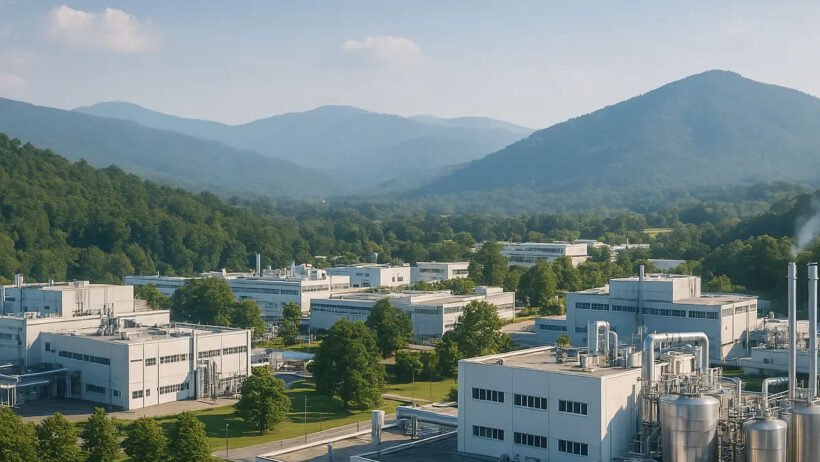Tucked away in Himachal Pradesh’s Solan district, the Baddi hub has earned its reputation as the “Pharma Capital of India” through its incredible industrial growth. This thriving center houses over 3,000 industrial units and includes some of the biggest names in pharmaceutical and manufacturing sectors.
In the last two decades, Baddi has revolutionized into a powerhouse for pharmaceuticals, manufacturing, education, and tourism. The industrial zone sits just a short drive from Chandigarh and has become one of Asia’s top medicine production spots with more than 2,000 factories, both local and global. The Himachal Pradesh government’s decision to designate it as a no-tax industrial area gives businesses major advantages.
What makes Baddi so appealing to pharmaceutical companies? How did this small town become India’s biggest pharma valley? This piece dives into the strategic location, government incentives, ecosystem, and how they shape Baddi’s role in India’s pharmaceutical industry.
Why Baddi Became a Pharma Powerhouse
A quiet town once, Baddi has changed beyond recognition since 2003. Today it stands as Asia’s largest pharmaceutical hub and one of north India’s biggest industrial centers. This dramatic rise happened because several key factors came together to create the perfect environment for pharmaceutical growth.
Strategic location and logistics
Baddi hub’s location gives it unique geographical advantages that are vital for pharmaceutical operations. The industrial belt sits between Shimla and Chandigarh with excellent road networks that help move raw materials and finished products quickly across India. Major cities like Chandigarh, Delhi, Punjab, and Haryana are just a short distance away, making it a perfect spot for logistics. Companies can streamline their supply chains, cut down on transport costs, and run more efficiently because of this prime location.
Government incentives and tax benefits
The life-blood of Baddi’s pharmaceutical success story began in 2003 with Atal Bihari Vajpayee government’s complete tax incentive package. This brilliant policy move included:
- Complete exemption on excise duty and income tax
- Investment subsidies for establishing manufacturing units
- Simple regulatory processes with fewer bureaucratic hurdles
The Himachal Pradesh government also made Baddi a Special Economic Zone (SEZ), giving businesses substantial advantages to set up shop. These benefits cut operational costs and brought in huge investments. In just four years until 2007, the state pulled in over Rs 19,000 crore as 861 medium and large-scale companies set up their bases here.
Affordable land and labor
Cost savings remain the main reason pharmaceutical companies choose Baddi hub. Companies find industrial land at good prices, reasonable labor costs, and cheap power supply here. So, they can keep production costs low while pricing their products competitively. Baddi’s appeal grows stronger with its steady supply of water and electricity—resources that pharmaceutical manufacturing cannot do without.
The industrial belt faces its share of challenges like poor connectivity, high transportation charges, and limited infrastructure in some areas. But minimal red tape, business-friendly policies, and cost benefits keep drawing pharmaceutical investments to this bustling hub. Pharmaceutical companies in Baddi now play a big part in the region’s yearly turnover of over Rs 30,000 crore.
Inside the Baddi Hub Ecosystem
Baddi’s pharmaceutical hub powers much of India’s drug manufacturing capabilities. Its network of businesses, reliable infrastructure, and talented workforce has created one of the country’s most productive industrial zones.
Over 3,000 industrial units
Baddi’s industrial area houses more than 3,000 manufacturing units that operate close to each other. This concentration has made the region Asia’s largest pharmaceutical clusters. A survey of India’s pharmaceutical clusters showed that Baddi contains some of the country’s largest pharmaceutical operations, with bigger pharma industries than other regions. Companies benefit from shared infrastructure and lower logistics costs due to their proximity.
Presence of top pharma companies
The hub features an impressive list of pharmaceutical giants with large manufacturing operations:
- Sun Pharmaceutical Industries runs advanced production facilities that focus on quality drug manufacturing
- Cipla operates modern manufacturing units that produce vital medicines for respiratory, cardiac, and infectious diseases
- Dr. Reddy’s Laboratories makes life-saving medicines distributed worldwide
- Aurobindo Pharma, Lupin, Glenmark, and Mankind Pharma run major operations
These pharmaceutical leaders make up about 35% of India’s total pharmaceutical production.
Supportive infrastructure and utilities
The area features well-laid-out industrial zones built specifically for pharmaceutical operations. The Export Promotion Industrial Park (EPIP) offers modern facilities with constant power supply, quality water access, and waste management systems. Companies maintain high operational standards through common effluent treatment plants, testing centers, and logistics facilities. This reliable infrastructure lets companies excel in production without utility issues.
Skilled workforce availability
A growing pool of specialized professionals strengthens the pharmaceutical ecosystem. These experts include pharmacists, engineers, chemists, and quality control specialists. Local training facilities produce workers who can operate complex machinery. The pharmaceutical companies’ partnerships with nearby universities and technical institutes create specialized training programs that boost graduate employability.
What Sets Baddi Pharma Apart Globally
Baddi hub stands out on the global pharmaceutical map with its remarkable infrastructure and unique advantages. This industrial powerhouse plays a vital role in the worldwide pharmaceutical supply chain.
High-quality manufacturing standards
Pharmaceutical facilities in Baddi follow strict quality protocols throughout their production process. The plants use advanced technology and maintain rigorous hygiene standards to ensure product safety and quality. Quality control remains their top priority. Manufacturers test raw materials extensively, inspect production procedures carefully and verify that final products meet quality benchmarks. Their steadfast dedication to quality has earned these facilities worldwide recognition.
Certifications: WHO, GMP, USFDA
Baddi hub’s credibility comes from its excellent regulatory compliance track record. WHO-GMP certification proves that manufacturers follow globally accepted best practices in pharmaceutical production. This certification guarantees consistent quality, safety, and efficacy standards in every medicine batch. India leads with the highest number of USFDA-compliant pharma plants outside the United States. These certifications serve as global passports that let manufacturers export products to countries with strict quality requirements.
Export reach to 200+ countries
Baddi hub’s global reach extends to more than 200 countries. India provides 50% of global vaccines and 40% of generic medicines used in the American market. The country supplies about 25% of all medicines used in the United Kingdom. Major export destinations include:
- USA, China, UK, Bangladesh, South Africa, Nigeria
- Russia, France, Australia, Canada, Brazil
- Germany, Japan, Turkey, Egypt, Indonesia
Innovation in generics and APIs
Baddi hub runs on pharmaceutical breakthroughs. India leads as the biggest supplier of generic medicines worldwide with a 20% share. It manufactures 60,000 different generic brands across 60 therapeutic categories. The country has 500 API manufacturers who contribute about 8% to the global API industry. These companies keep investing in research and development to create new formulations and delivery systems that improve their global market position.
Challenges and the Road Ahead
The Baddi hub’s remarkable success now faces big challenges that could affect its market leadership. Companies here compete fiercely in the global market and must innovate constantly to keep their market share. Smaller firms struggle especially with resource strain and higher operational costs.
Rising competition from other regions
The pharmaceutical world changes faster than ever as new manufacturing hubs emerge across India and globally. Baddi’s companies must direct their way through complex rules set by national and international authorities. This process needs substantial resources to meet compliance standards. Recent supply chain problems have exposed weak points that affect raw material access and distribution networks.
Need for sustainable practices
The region’s development has made environmental concerns a top priority. The biggest problem comes from increasing pollution levels and industrial waste management. Many pharmaceutical companies now choose environmentally responsible manufacturing processes to reduce waste and protect nature.
Focus on R&D and innovation
Digital transformation offers vital chances for growth. Technologies like “artificial intelligence”, “machine learning”, and automation can optimize R&D processes and manufacturing efficiency. The pharmaceutical sector should welcome innovation to advance in the value chain, especially with complex generics and specialized drugs.
Expansion of educational institutions
Education development is a vital part of sustained growth. Local universities work with pharmaceutical companies to create specialized training programs in quality assurance and regulatory compliance. The new Center of Excellence will offer customized training modules and build strategic collaborations with academic institutions to improve industry competitiveness.
Conclusion
Baddi hub is proof of well-planned industrial development and strategic government policies. This small town’s experience to become India’s pharmaceutical powerhouse has reshaped the scene of pharmaceuticals across the nation. The perfect environment for pharmaceutical growth emerged from its strategic location, substantial tax benefits, and affordable resources.
The thriving ecosystem has over 3,000 industrial units now. Major pharmaceutical giants like Sun Pharmaceutical, Cipla, and Dr. Reddy’s contribute about 35% to India’s total pharmaceutical production. Strict quality controls and international certifications like WHO-GMP and USFDA have without doubt enhanced Baddi’s global reputation. Its products now reach more than 200 countries worldwide.
Notwithstanding that, the road ahead has its most important challenges. Competition from emerging manufacturing hubs grows stronger and environmental issues need immediate attention. Baddi hub’s future success depends on accepting new ideas for green practices, investing in research and development, and building educational partnerships for specialized talent.
Baddi’s development offers a blueprint for successful industrial growth. The pharmaceutical valley brings substantial economic benefits and establishes India as a global leader in generic medicines and API production. The fundamentals that made Baddi India’s pharmaceutical capital remain strong, despite various challenges. This suggests continued growth and breakthroughs over the last several years. Baddi’s story shows how targeted policies, infrastructure development, and industry collaboration can turn a small town into a global manufacturing powerhouse.
FAQs
Q1. What makes Baddi the largest pharmaceutical hub in India? Baddi’s success as India’s biggest pharma valley is due to its strategic location, government incentives, affordable resources, and a thriving ecosystem of over 3,000 industrial units. The region offers excellent connectivity, tax benefits, and a skilled workforce, making it attractive for pharmaceutical companies.
Q2. Which major pharmaceutical companies have operations in Baddi? Several top pharmaceutical giants have established significant manufacturing operations in Baddi, including Sun Pharmaceutical Industries, Cipla, Dr. Reddy’s Laboratories, Aurobindo Pharma, Lupin, Glenmark, and Mankind Pharma. These companies collectively contribute about 35% to India’s total pharmaceutical production.
Q3. How does Baddi’s pharmaceutical industry impact global markets? Baddi’s pharmaceutical products reach over 200 countries worldwide. The hub plays a crucial role in supplying generic medicines and APIs globally, with India providing 50% of global vaccine demand and 40% of generic medicine requirements in the American market.
Q4. What certifications do Baddi’s pharmaceutical facilities hold? Pharmaceutical facilities in Baddi adhere to high-quality manufacturing standards and hold important certifications such as WHO-GMP and USFDA compliance. These certifications ensure that the products meet international quality, safety, and efficacy standards, enabling exports to countries with strict quality requirements.
Q5. What challenges does the Baddi pharmaceutical hub face? The Baddi hub faces challenges including rising competition from other regions, the need for sustainable practices, and the importance of focusing on R&D and innovation. Additionally, the hub must address environmental concerns, adapt to digital transformation, and expand educational institutions to maintain its competitive edge in the global pharmaceutical market.








